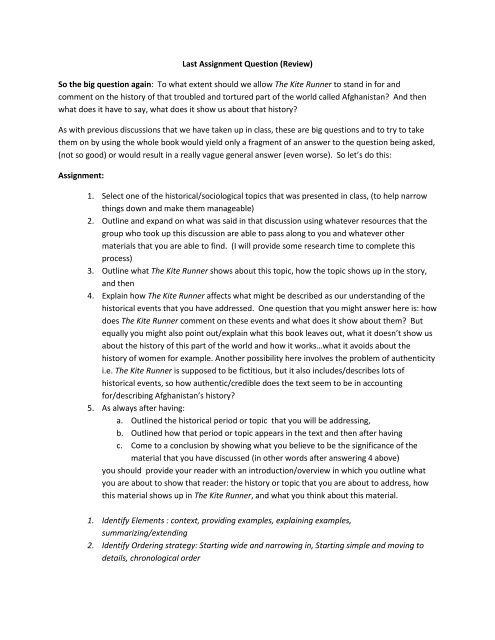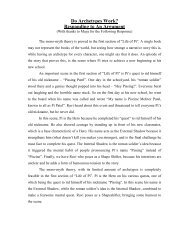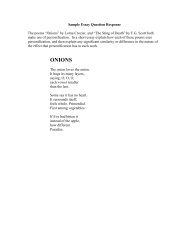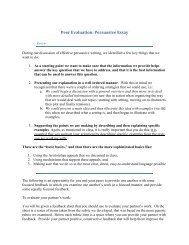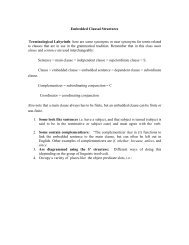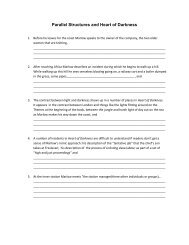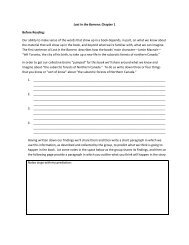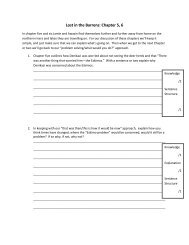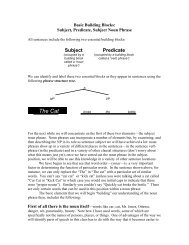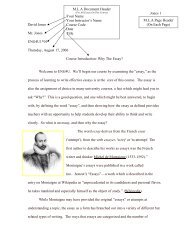To what extent should we allow The Kite Runner ... - with david jones
To what extent should we allow The Kite Runner ... - with david jones
To what extent should we allow The Kite Runner ... - with david jones
Create successful ePaper yourself
Turn your PDF publications into a flip-book with our unique Google optimized e-Paper software.
Last Assignment Question (Review)So the big question again: <strong>To</strong> <strong>what</strong> <strong>extent</strong> <strong>should</strong> <strong>we</strong> <strong>allow</strong> <strong>The</strong> <strong>Kite</strong> <strong>Runner</strong> to stand in for andcomment on the history of that troubled and tortured part of the world called Afghanistan? And then<strong>what</strong> does it have to say, <strong>what</strong> does it show us about that history?As <strong>with</strong> previous discussions that <strong>we</strong> have taken up in class, these are big questions and to try to takethem on by using the whole book would yield only a fragment of an ans<strong>we</strong>r to the question being asked,(not so good) or would result in a really vague general ans<strong>we</strong>r (even worse). So let’s do this:Assignment:1. Select one of the historical/sociological topics that was presented in class, (to help narrowthings down and make them manageable)2. Outline and expand on <strong>what</strong> was said in that discussion using <strong>what</strong>ever resources that thegroup who took up this discussion are able to pass along to you and <strong>what</strong>ever othermaterials that you are able to find. (I will provide some research time to complete thisprocess)3. Outline <strong>what</strong> <strong>The</strong> <strong>Kite</strong> <strong>Runner</strong> shows about this topic, how the topic shows up in the story,and then4. Explain how <strong>The</strong> <strong>Kite</strong> <strong>Runner</strong> affects <strong>what</strong> might be described as our understanding of thehistorical events that you have addressed. One question that you might ans<strong>we</strong>r here is: howdoes <strong>The</strong> <strong>Kite</strong> <strong>Runner</strong> comment on these events and <strong>what</strong> does it show about them? Butequally you might also point out/explain <strong>what</strong> this book leaves out, <strong>what</strong> it doesn’t show usabout the history of this part of the world and how it works…<strong>what</strong> it avoids about thehistory of women for example. Another possibility here involves the problem of authenticityi.e. <strong>The</strong> <strong>Kite</strong> <strong>Runner</strong> is supposed to be fictitious, but it also includes/describes lots ofhistorical events, so how authentic/credible does the text seem to be in accountingfor/describing Afghanistan’s history?5. As always after having:a. Outlined the historical period or topic that you will be addressing,b. Outlined how that period or topic appears in the text and then after havingc. Come to a conclusion by showing <strong>what</strong> you believe to be the significance of thematerial that you have discussed (in other words after ans<strong>we</strong>ring 4 above)you <strong>should</strong> provide your reader <strong>with</strong> an introduction/overview in which you outline <strong>what</strong>you are about to show that reader: the history or topic that you are about to address, howthis material shows up in <strong>The</strong> <strong>Kite</strong> <strong>Runner</strong>, and <strong>what</strong> you think about this material.1. Identify Elements : context, providing examples, explaining examples,summarizing/extending2. Identify Ordering strategy: Starting wide and narrowing in, Starting simple and moving todetails, chronological order
women are to be treated mostly as a form of property that is to be keptcovered, and not allo<strong>we</strong>d in public places <strong>with</strong>out being accompanied by amale family member. <strong>The</strong> Taliban interpretation of the Koran isaggressively fundamentalist, punative and violent, and has resulted in, forinstance, the ongoing slaughter of ethnic Hazaras in Afghanistan duringtheir rule, mostly because the Hazaras are Shiite Muslims.<strong>The</strong> appearance of <strong>The</strong> Taliban in Khalid Hosseini’s novel <strong>The</strong><strong>Kite</strong><strong>Runner</strong> is probably some<strong>what</strong> ske<strong>we</strong>d, relative to <strong>what</strong> was reallyoccurring in Afghanistan during the period. In the book Hosseini’s heroAmir goes back to Afghanistan from his home in San Francisco in order torescue <strong>what</strong> he eventually finds out is the son of his half-brother Hassan.Amir has had a tortured, guilt ridden relationship <strong>with</strong> Hassan as he hadseen Hassan raped by a boyhood bully named Assif, when Amir, Hassanand Assif <strong>we</strong>re young. Amir felt guilty about the rape because he did nothelp Hassan and because he had not been able to tell anyone about the rapeand his not helping Hassan.On returning many years later to Afghanistan at his dad’s businesspartner’s request, the partner, Rhamin Khan, tells Amir that Hassan was hishalf-brother. We also find out that Hassan, a Hazara, and his wife hadbeen shot and killed in the street by the Taliaban while looking afterAmir’s family home. Ramin Khan then convinces Amir to go back toAfghanistan at the height of the Taliban rule, to rescue Hassan’s sonSohrab.
<strong>The</strong> story of Amir’s trip to rescue Sohrab and then his subsequentreturn from Afghanistan, while not necessarily untrue sounding issome<strong>what</strong> unusual, as the primary representative of Talib rule that Amireventually has to deal <strong>with</strong>, is his old childhood bully/nemesis, Assif.Assif is half German, and Hosseini sets Assif up as admiring Hitler evenwhen Amir and Hassan <strong>we</strong>re kids. He is also clearly a very troubledindividual in the early (younger) part of the book as he eventually rapesHassan in a part of the world where, both rape and homosexuality aresignificant crimes. When Amir meets Assif again later as an adult Assifhas turned into a sunglass <strong>we</strong>aring Taliban executioner who stones Sharialawbreakers sentenced to death as part of a soccer game half-time show.Amir soon finds that Assif’s parents are doing <strong>we</strong>ll in Western Australia,owning restaurants and other businesses, that Assif is a heroin addict andthat Sohrab is his child love-slave. Assif, as such, isn’t really thatrepresentative of the Taliban: he likes the Taliban because they believe inethnic purity the way that Hitler did, but he isn’t really an Islamic religiouszelot of any sort and would probably become a victim of Sharia lawhimself if, for instance, the fact that he was gay, and involved in rapingchildren was discovered by the Taliban—an organization known formaking no exceptions where the law is concerned, an organization famousfor events like the gruesome public executions of even its own members(notably by hanging them from the gun barrel of a tank) if found guilty ofraping women.
<strong>The</strong> Afghanistan depicted in the latter, “Taliban” parts of the <strong>Kite</strong><strong>Runner</strong> seem realistic as a personal drama, the ongoing vendetta bet<strong>we</strong>en acouple of characters: Assif—a sociopath, and Amir—the hero that musteventually face this sociopath. But neither of these characters arerepresentative of the world of the Taliban and the difficulties that it mayhave brought to the people of Afghanistan. As Amir first makes his wayinto Afghanistan across the Pakistan border on his trek to save Sohrab, hesees that Afghanistan has become a shambles, and says “I feel like atourist in my own country” to his driver Fahrid. Fahrid, who isrepresentative of another class relative to Amir in the old Afghanistan,responds to Amir by pointing out that “You’ve always been a tourist here,you just didn’t know it.” Fahrid points out that <strong>what</strong> Amir has seen hasalways been pretty limited by his social status: he had seen something ofAfghanistan, but because he was in an upper-class neighborhood he hasn’tseen that much. It would be worth remembering, in this respect, that asreaders of <strong>The</strong> <strong>Kite</strong> <strong>Runner</strong> <strong>we</strong> have seen something in the latter parts ofthe book, and while the struggles bet<strong>we</strong>en Amir and Assif are interesting,they are nonetheless limited, and not really representative of the realstruggles that have, and no doubt continue to occur in Afghanistan. Asreaders <strong>we</strong> have been entertained by a pretty sensational story, <strong>with</strong> theunderstanding being that, as was the case <strong>with</strong> Amir in his upper-classAfghani upbringing, <strong>we</strong>stern audiences need to be entertained, and if Assifisn’t representative, he is at least a sensational—he’s a gay, rich-kid,
heroin addicted, child molesting, half-German neo-nazi—and in his demisekeeps us entertained. But sensationalism is like living in an upper-classsuburb of Afghanistan: you see something, but where the real, day-to-day,boring, arduous struggles of a people trying to get by <strong>with</strong> nothing areconcerned, <strong>we</strong>’re still tourists: <strong>we</strong> haven’t been told that much.Overview (Written after the previous material)Khalid Hosseini’s work <strong>The</strong> <strong>Kite</strong><strong>Runner</strong> appears to provide its reader <strong>with</strong> arepresentation of, among other things, life under the Taliban. <strong>The</strong> novel is notthat representative though, and replaces the day to day drudgery of <strong>what</strong> life inTaliban Afghabnistan might include, <strong>with</strong> a pretty sensational story that keepsreaders entertained but that doesn’t really represent the period being described.In order to show how this is the case it will first be necessary to outline thehistory of the period, and the Taliban’s role in this history, and then to outlinehow this period shows up in the novel.


